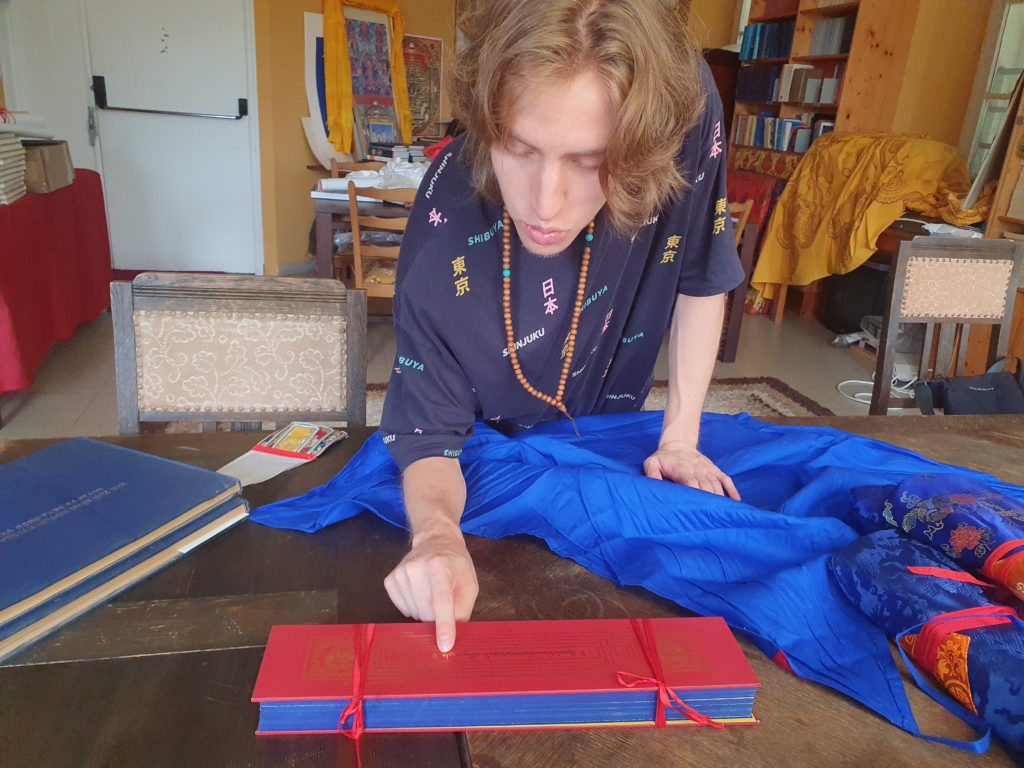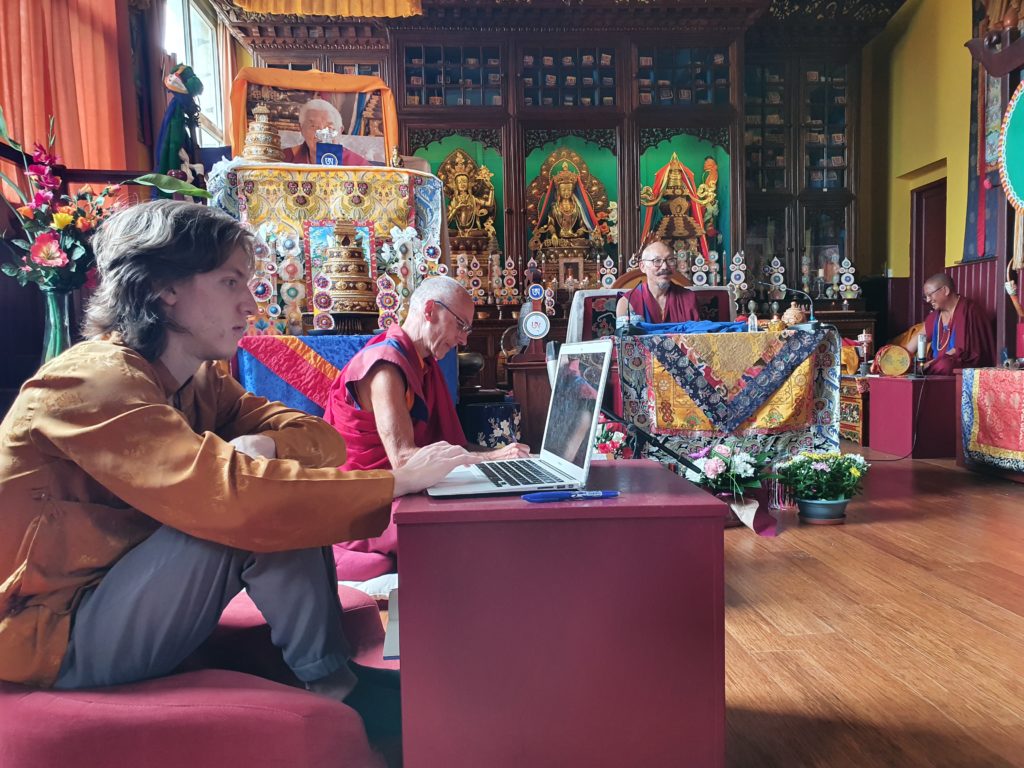Language of prayers is difficult to understand, Ponse Yigme Tenzin says

Tulku Ponse Yigme Tenzin has been recognized as the reincarnation of Lopon Sangye Tenzin, the teacher of Yongdzin Tenzin Namdak and the first Lopon of Menri monastery in Dolanji, India. This led him to study Tibetan language so that he could understand and eventually teach the doctrine of Yungdrung Bon. This is the second part of an interview which took place in August of 2022.
How long did it take you to learn Tibetan language to the level that you can read texts of the teachings?
It took many years, actually, but with interruptions. I started very early, when I was five or six. Lamas and geshes used to come regularly to my home, and some of them had been teaching me Tibetan. I started with the Tibetan alphabet when I was six, and then they taught me how to read uchen and ume. Uchen is a Tibetan writing used in printed, western style books. Pecha books, the traditional Tibetan books with separate pages, are written in ume, which is similar to uchen but you have to learn it as well, by only knowing uchen I could not read ume.
First you are a tulku just by the name, but then you have to earn it
“One day, when they were already in Menri, it was raining and my father found a shelter on the porch of a building of the monastery. He did not know that the building was the house of His Holiness Menri Trizin. When it stopped raining, His Holiness came out and asked my father: “You are Jorge Valles, aren´t you? I just came out of a three-day long meditation where I was asking for signs, and you are the first person I met after I left, and you see, there is not one, but two rainbows in the sky, stretching from east to west.” This is how my father tells the story. Also, His Holiness pointed out to a cuckoo sitting on a tree nearby, which is considered another auspicious sign.”
When I was seven, I started to go to the Menri monastery for two three months each year, together with my parents. When I was twelve, I spent an entire year there, on my own. It was then when I started to study in a more consistent way. I had four classes per day with my tutor: reading, grammar, some degree of comprehension, and writing. Then I had also ritual classes: how to perfom Yeshe Walmo and gom cho nam sum and chod. After one year my Tibetan improved a lot.
Then you had to finish the school in Mexico…
Yes, I came back to Mexico and continued my school. Then Yungdrung Tsultrim, my tutor from Menri, went for one year to Mexico, and I studied with him at home. Not so intensely as at the monastery, because I had to combine them with my regular school. After he left I did not have any regular classes for some years, I just went to the retreats and spent time with monks trying to understand them. But honestly speaking, my Tibetan was still quite poor. I could read since I was very little, but the meaning was not there. And I could talk only about very superficial things.
When I finished my high school, I went to Lishu Institute in India for three months and then I studied at a university in Mexico Financial administration. For my fourth semester I went to Budapest to an affiliated university. I was there when Holiness Menri Trizin passed away, he entered the parinirvana in 2017.
I went to Menri monastery for the funeral ceremony, after quite many years that I had not been there. That time Menri Ponlop Rinpoche and Chongtrul Rinpoche and other lamas encouraged me to deepen my studies of Bon. It was their impuls that made me take a decision to learn Tibetan properly.
I searched for a good school for that, and I was advised to go to Lotsawa Rinchen Zangpo Translator Program in Dharamsala, India, by a few people whose opinion matters to me.

What is the studying program there?
It is two years of intense training in the school in India followed by a two-year course for translators done more practically and outside the school. Usually people become translators of Tibetan teachers into other languages enroll. I enrolled only for the first part, in the years of 2018 and 2019. The program starts from the very beginning and for about two months, I could use my previous knowledge, but not more. When the second module began, it was all new for me. The first year we studied modern, colloquial language. The classical Tibetan was taught only once a week and not very well, I built my knowledge mainly by myself, I studied many manuals of classical Tibetan on my own. To learn grammar and structure of sentences does not take so much time, for classical Tibetan. The hard part starts when one has to interpret what the texts say. We studied a text from the Gelugpa tradition, to which the school belongs, Lam rim chenmo, Stages of the path to enlightenment.
The second year we had classes only in Tibetan, and when I completed eight modules out of nine, I felt that I was ready to continue my studies in the Bon tradition, and I went to Triten Norbutse.
Do you still need a somebody´s help to understand a text?
Yes, in each text there are words for which I need an explanation. Also, sentences in the texts of teachings are quite long, some cover several paragraphs, and the verb is always at the end, so you need to read the whole sentence before you catch the meaning. With lots of practice, it comes. I am also in the Shedra, the two-week dialectical course organized by Shenten. We read a quite difficult text, Salaam –Path and Stages to Enlightment, written by Nyame Sherab Gyaltsen.
I realized that sometimes can be easier to explain a part of the text than to translate it. Translating needs to be close to the text and some figurative expressions is really hard to deliver. The traditional texts are also written in a very concise, condensed way.
There is a tendency of omitting some words which then should be deduced. This of course applies to lots of texts of the teachings written in the antient times. For example, I was just studying a text with Khenpo Rinpoche from the first of Nine vehicles of Bon. There is a word – sung-wa – which means to protect something, to guard something. Sometimes in the text it is used in a way that it may seem that you should protect yourself by doing wrong things, but this only because a particle is omitted, while it means, in that context, that you should protect yourself from doing wrong things. For this, you need an explanation from someone knowledgeable.
Is the language of the prayers even more difficult to understand?
It is. Understanding a text of teaching is comparably less difficult than understanding prayers. Old prayers are written in verses and some omission in the prayers are due to the need to have the same number of words, or syllables, in one verse, for example. That´s why translating prayers is very difficult. Sometimes key words or concepts are missing, and you have to understand them from the context or experience and add them in the translation.
Lopon Sangye Tenzin Rinpoche was the first lopon, or head teacher, of Menri Monastery in India.
Born in 1917 into the Jyab ‘Og family, an esteemed lineage within the Bön tradition, he lived his early years in the nomadic region of Hor, Tibet. He studied for many years in the Drepung Monastery of the Gelug tradition, as well as under masters of other schools of Tibetan Buddhism. He became an accomplished master of sutra, tantra and dzogchen. He lived a simple life, much of it in solitude, yet he was considered by many to be the greatest Bön scholar of his generation.
Photos: Jitka Polanská

